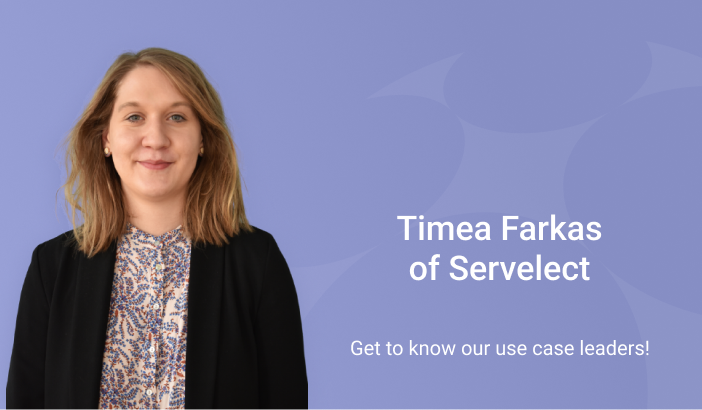
16 Mar Get to know our Use case leaders! Timea Farkas has two tips for SMEs to become greener and save energy
Dear Timea Farkas, please introduce yourself!
Timea Farkas: My name is Timea Farkas, I am 25 years old. I am working as a Research Engineer within Servelect, an energy service company in Cluj-Napoca in Romania. Besides this, I am currently pursuing a doctoral program in the field of Electrical Engineering at the Technical University of Cluj-Napoca (TUCN). I hold a Master’s degree in Renewable Energy Technologies and my current professional interests are focusing on renewable energy technology integration and energy efficiency in industry and urban communities, including research & development.
What inspires you about the GEAR@SME project?
Working within an international consortium and learning from different partners inspires me for having new ideas, to improve the work we are doing within the project. Besides this, the collective approach applied by the project opens new opportunities for everyone interested in energy efficiency and empowers the teamwork mindset.
What exactly do you do as a Use Case Leader?
As a Use Case Leader, I am responsible to follow the activities within the project and synchronizing them with the Use Case activities. Together with my colleagues, we ensure to keep communication with the use case actors: ADLO, the Trusted Partner, SMEs within the industrial parks, energy service suppliers, associations, and other potential stakeholders and to disseminate potential events or opportunities created by the project to maximize the impact in Romania.
Please tell us something about the Use Case. What makes it stand out? How big is it? What kind of companies are involved etc.?
The Oradea Industrial Platforms are managed by Oradea Local Development Agency (ADLO), the Trusted Partner of the Use Case. Being at the border of Hungary, the platforms represent a key facility for industry, including local and foreign investors. The company is managing six industrial parks with a total area of approximately 250 ha in Bihor County with more than 100 companies from different sectors, including the textile industry, manufacturing, and service sectors.
What role has climate protection and energy saving played for SMEs in your region so far?
The existing national legislative framework does not oblige SMEs to assign energy managers or to conduct energy audits within the company. This is the main reason why generally the level of energy management and energy efficiency within SMEs is low. Working with SMEs concluded that they are interested to identify energy and cost saving measures, but several barriers are stopping them. Besides cost reduction, the interest in climate change and reducing greenhouse gas emissions are under the spotlight, which has to be further tackled by initiatives such as the GEAR@SME project.
What have you been able to achieve in the use case so far?
Firstly, we identified a Trusted Partner, along with a potential SME community. SMEs were mostly excited to be part of the project. The four SMEs who accepted the energy scan offer, invited our team to have an on-site visit and to show us the technological processes to understand better their needs. Having face-to-face discussion was a key success in the use case. In addition, Servelect and TUCN organized a successful workshop where the team presented the GEAR@SME methodology and useful information regarding training and financing opportunities and innovative renewable energy sources, creating synergies with other Horizon 2020 projects. Lack of national best practices and experience in terms of collective approach slows down the process towards creating an SME energy collective, but knowledge sharing, networking and multiple benefits can tailor the pathway towards energy efficiency & sustainability, approached in a collective way.
What was the best experience for you in the project?
One of the most pleasant experiences gained during the Use Case activities happened during the energy scan we performed together with TUCN at four SMEs. All of them were very enthusiastic to show us the technological process and what they achieved in terms of development, also to share ideas for potential EE measures. Two days weren’t enough to discuss everything, but everybody was pleased to keep the communication and have future visits. After the energy scans, the team concluded that SMEs’ doors are open, and they do need help for finding the best measure. In addition, some of them emphasised that being part of a community of professionals can have great benefits.
Do you have any tips on how best to get SMEs to go greener and save energy?
I have two tips for SMEs: Firstly, start with small steps. Energy efficiency might not be a priority but can be part of your work. Organizational measures can be a first step towards saving energy. Secondly, improve your knowledge, share your experience. SMEs might not have energy management but often there is a person who knows everything in the company. Look for education and training opportunities to improve your technical and financial knowledge. Also, share the experience with those in the same sector/situation. A piece of good advice can help you take several steps ahead. The best way to reach SMEs is by identifying specific needs and barriers and then using specific drivers to convince them to be on board.
What can we (or the SMEs) look forward to in the project?
In the near future we are planning dedicated trainings and implementation of the energy assessment tools for supporting the Trusted Partner and SMEs in prioritising energy efficiency in the current context of high energy prices. Also, we would like to introduce the multiple benefits approach in the energy professional’s community.
Thank you for the interview.


